Indiana Limestone Company
The Indiana Limestone Company was formed on April 14, 1926 after the merger of smaller limestone quarrying companies. In 2018 it was owned by Canadian-based Polycor, the world’s largest dimension stone quarry company.
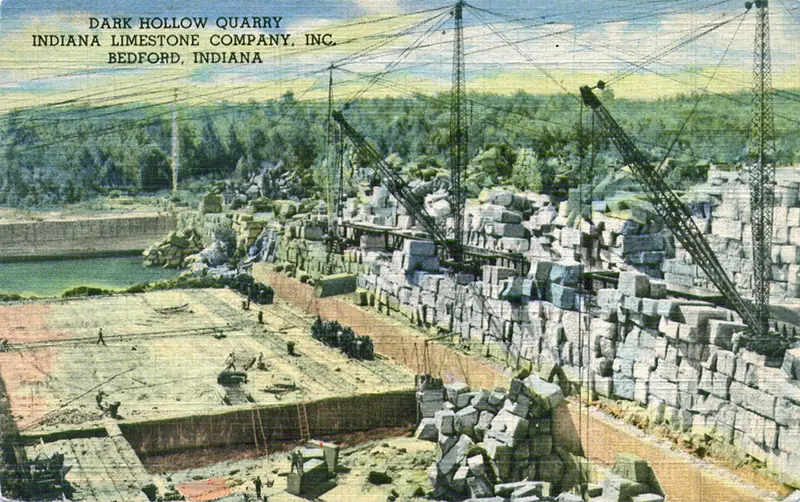
Indiana Limestone Company: Dark Hollow Quarry, Bedford, Indiana
The text on the postcard says, "Dark Hollow Quarry is one of the oldest producers of the nations's building stone. It is noted for its excellent quality of buff, gray and variegated limestone. Several Washington, D. C. Federal buildings were built of this stone. Many other Indiana Limestone Company quarries are at peak operation in Lawrence and Monroe Counties, the heart of the Indiana Limestone belt."
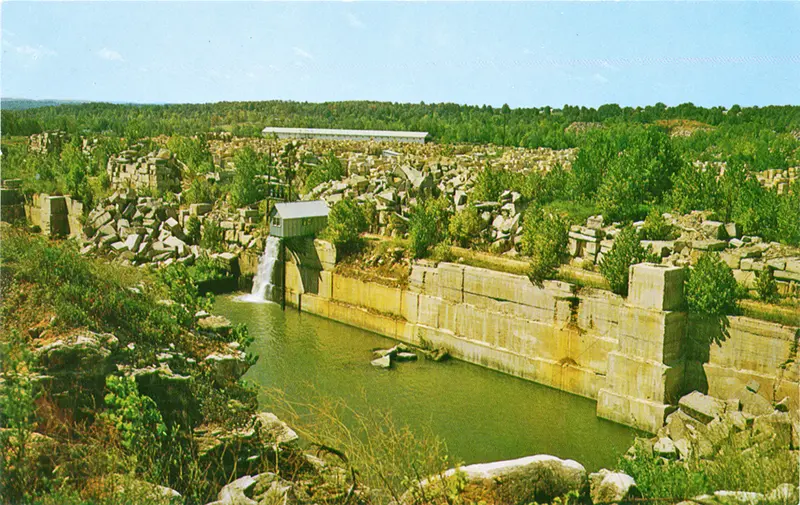
Indiana Limestone Company: Walsh Quarry, Bedford, Indiana
The text on the postcard says "This scene of the Indiana Limestone Company, the largest limestone company in the world, was taken at the north edge of Oolitic. It shows the Joiner Mill in the background, large stacks of huge blocks of stone and water reservoir at the Walsh Quarry. The water is used in the mills. Some of the blocks of stone weigh as much as 25 tons."
In 1948, the Walsh Quarry is reported to be the largest building limestone quarry in the world. It was named for John R. Walsh, a Chicago financier, who purchased it from the Bedford Quarries Company in 1895.
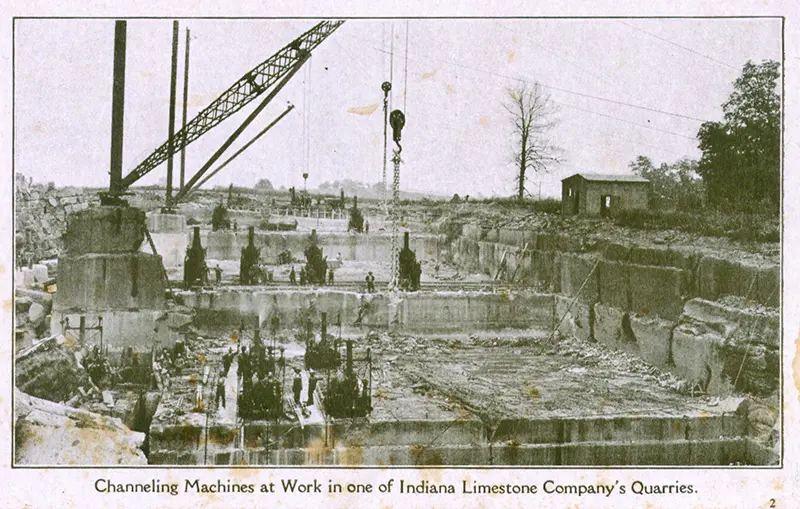
Channeling Machines at Work in one of Indiana Limestone Company's Quarries
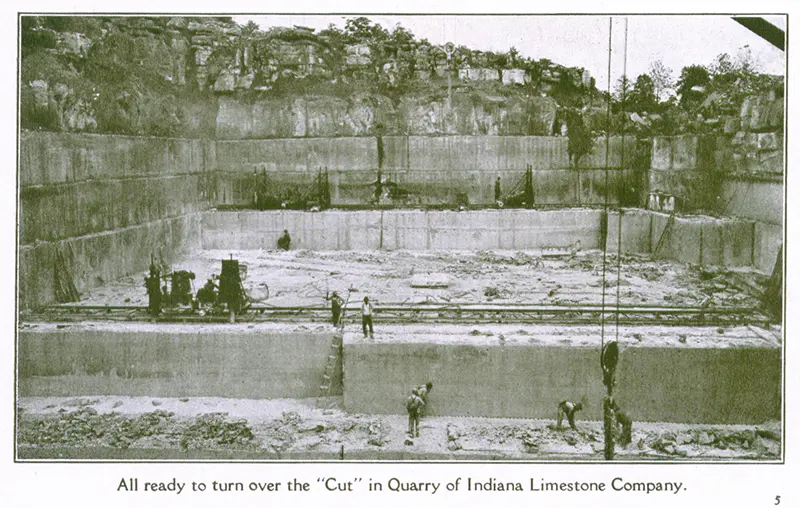
All ready to turn over the "Cut" in Quarry of Indiana Limestone Company
An investigation by the U.S. Department of Labor, Mine Safety and Health Administration (Internet Archive) into the death of a quarry worker at the Maple Hill Quarry, owned and operated by B. G. Hoadley Quarries, near Bloomington in 2000, details how these "cuts" are made...Limestone was mined from multiple benches. A diamond belt saw cut the limestone into 120-foot long, 10-foot high, by 4-foot deep sections. The section was cut by slips-and-wedges to 6-foot and 10-foot long blocks which were transported by front-end loaders to the storage yard. Some blocks were sawed into desired slabs. Others were sold uncut. Some of the off-color blocks were transported to the cull block storage area about 1/8th mile behind the saw, where weathering after a period of time changed their color and made some of them useful for special orders. The blocks and sawed slabs were sold for construction materials.
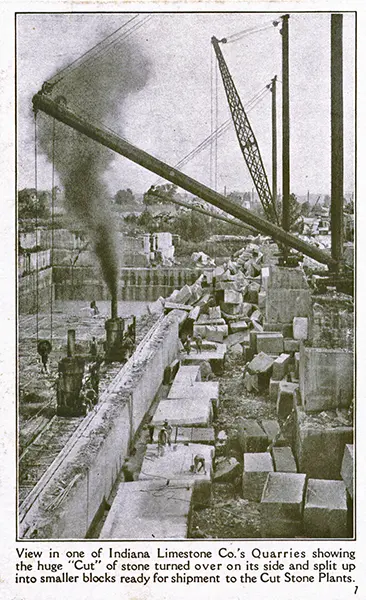
Splitting a "Cut"
The postcard text is "View in one of Indiana Limestone Co's quarries showing the huge "Cut" of stone turned over on its side and split up into smaller blocks ready for shipment to the Cut Stone Plants."
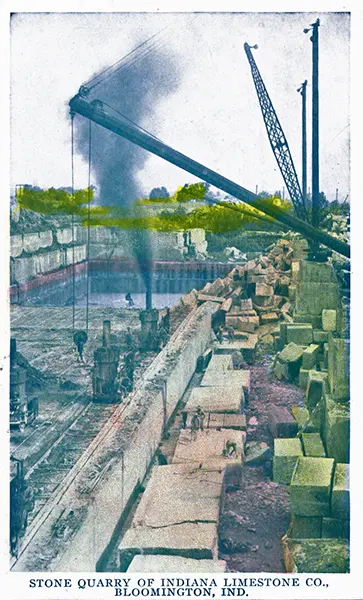
Splitting a "Cut"
The postcard text is "Stone Quarry of Indiana Limestone Co., Bloomington, Indiana"
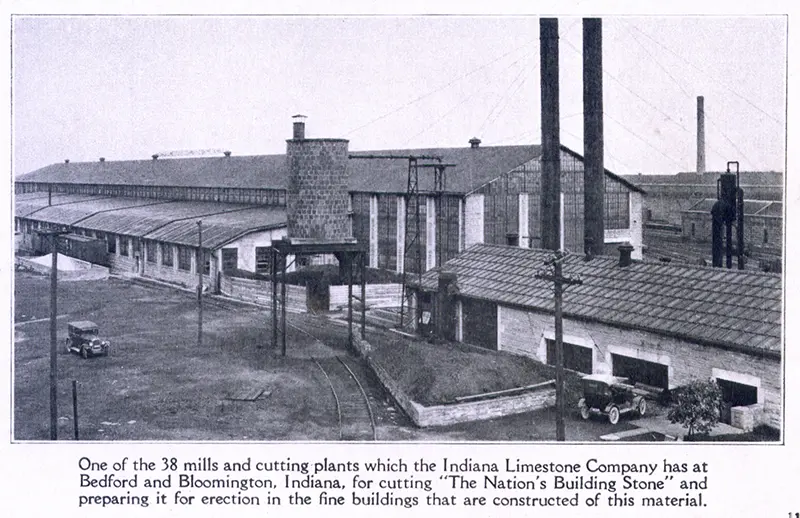
Indiana Limestone Company mill
The text on the postcard reads "One of the 38 mills and cutting plants which the Indiana Limestone Company has at Bedford and Bloomington, Indiana, for cutting "The Nation's Building Stone" and preparing it for erection in the fine buildings that are contructed of this material."
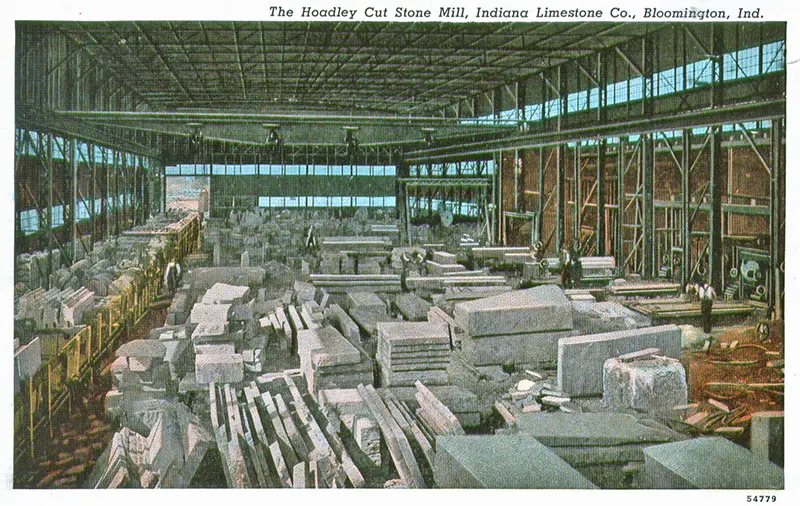
Indiana Limestone Company: Hoadley Cut Stone Mill, Bloomington, Indiana
There were several people named Hoadley who owned stone mills in Indiana. The following are extracts from the Gazetteer of Limestone Mills of Owen, Monroe, and Lawrence Counties to 1950
There were two mills of the J. Hoadley and Sons Company on the south edge of Stinesville that were built sometime prior to 1896. The one on the west of the railroad was the larger of the two and burned in about 1916. After the fire the company left Stinesville and moved its milling operation to Bloomington where it built the Tribune Mill. The stone for the Tribune Building in Chicago came from this mill . It was located just south of Grimes lane and on the east side of the railroad tracks. It was gone by the 1940's and nothing remains of it.
The Bloomington Cut Stone Cmpany built a mill in 1906. John Hoadley of the Hoadley Stone Cmpany bought it in about 1914 or 1915 and doubled its size. From then until the merger in 1926 it was Mill B of the Hoadley Stone Company. After the merger it was the Bloomington Mill of the Indiana Limestone Company. It was razed sometime in the 1940's and nothing remains. It was located midway between First and Dodds Streets and ran in an east and west direction with the west end along the Monon tracks.
A large mill was located just north of Grimes Lane and east of the railroad tracks. John W. Hoadley, Jr. built this mill in 1906. His company was the Hoadley Stone Company and is not to be confused with the J. Hoadley & Sons Company who built the Tribune Mill across Grimes Lane to the south. After the merger the Mill A of the Hoadley Stone Company was called the Hoadley Mill and later the Indiana Mill of the Indiana Limestone Company. It was gone by the early 1940's and nothing remains at the site.
The Hoadley-Cline Stone Company Mill was another mill that had to have been built sometime between 1913 and 1927. Kenneth Cline and Ellsworth Hoadley built it. Their company was one of those that merged in 1927 to become the Bloomington Limestone Company. (This is not to be confused with the much larger merger the year before that formed the giant Indiana Limestone Company.) The mill was located about midway between Walnut and Morton Streets and was on the north side of Allen Street. It is no longer there.
John Hoadley. Jr. built a four gang mill about 1923. His company was one that merged in 1926 and afterward the Indiana Limestone Company added two gangs and named the mill the Wicks Mill. It was shut down in about 1930. It was due north of the Crescent Mill and, at least until 1950, some foundations could be seen about forty yards due west of the junction of new Highway 37 and the Highway 46 bypass north around Bloomington.
The mill of the Sare-Hoadley Stone Company was built sometime during the 1920's. In the 1950's the building was removed and utilized to expand the mill of the new Woolery Stone Company Mill. In the 1990's a few foundations can be seen along the north side of the Smithville Road just west of the Smithville Telephone Company building.
The B. G. Hoadley Quarries Company Mill was built in 1928 and in 1950 was still in the business of milling limestone.
J. Mason Hoadley built a mill in 1930. It is still there in 1950 but by 1969 was no longer a stone mill. It was located on the west side of Highway 37 south of the site of the Mutual Oolitic Stone Company Mill. The Bloomington Telephone, March 29, 1930 edition carried this article...
J. Mason Hoadley in association with J.W. Hoadley announces the building of a $150,000 cut stone company to be located in the belt east of the Monon yards on the Dixie. The new mill, 164 by 150 feet, is known as J. Mason Hoadley, Incorporated, with 10,000 shares of stock, no par value.
We believe in the future of cut stone in Bloomington or we would not build at a time when some mills are not running, said J. Mason Hoadley in speaking of the plans for the new building.
Comparing in size with the Hoadley-Cline company and the Bloomington mill of the Indiana Limestone company the new mill will be fire-proof throughout with galvanized siding and highest grade asbestos roofing. The mill will employ 45 to 50 men with the following equipment: 5 planers, 2 gang saws, 3 diamond saws, 2 travelers, and 2 tramways with covered leanto.
The name Hoadley has long been associated with stone in the belt. J.W. Hoadley, Sr. began operation at Stinesville after the civil war about 1880. After a disastrous fire the Hoadley Stone company was formed in Bloomington in 1903. The present J. W. Hoadley carried on the business of his father in Bloomington and later in association with his son, J. Mason Hoadley, built up a large and profitable business. J. Mason Hoadley was associated with his father for about 10 years before and after the world war as general manager of the Hoadley Stone company. In 1926 the Hoadley stone company was sold to the Indiana Limestone company and J. Mason Hoadley became superintendent of the Hoadley Mill of the Indiana Limestone company for two years. He then left the stone business and re-entered as part owner of one of the larger cut stome mills of the belt.
Buskirk and Dodds were awarded the contract for laying the foundation of the new mill. The Bedford Foundry and Machine company received the structural contract and Seward and Company will install an Ingersol-Rand air compressor. Work has already begum on the new cut stone mill.
The Perry Brothers firm became the Perry Stone Company after Henry retired in 1896 and Gilbert Perry died in 1898. About 1940, William Hoadley bought the Perry Stone Company, which was in receivership. A few years later William McNeely bought the mill from William Hoadley.
It must have been a slow news week for the Bloomington Evening Weekly, January 29th, 1917 edition which carried this story on the front page...
At ten o'clock last Saturday night fire was discovered in the tool room of the Hoadley Stone Mill on south Morton street. The fire department made a quick run and soon had the blaze under control. The damage would not be more than $15. Origin of the fire is unknown.
B. G. Hoadley Quarries was incorporated in 1926 but traces its roots to the earlier Hoadley companies starting around 1880.
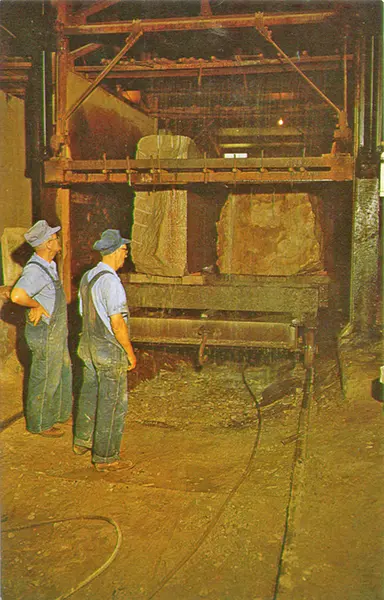
Indiana Limestone Company: Joiner Mill, Bedford, Indiana
The text on the postcard says "This scene is inside the Joiner Mill, of the Indiana Limestone Company, the largest limestone company in the world. The gang saws are sawing a huge block of limestone for custom or veneer use. These large blocks may weigh as much as 25 tons. The jets of water wash out the slush that accumulates. The two men are seeing that everything is working smoothly."
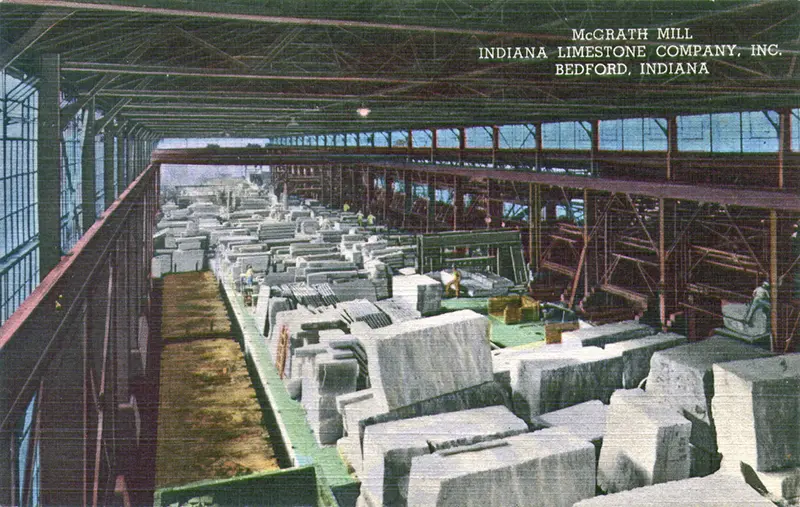
Indiana Limestone Company: McGrath Mill, Bedford, Indiana
The McGrath Mill was built in 1924 by Maurice McGrath of the Inter-state Cut Stone Company.
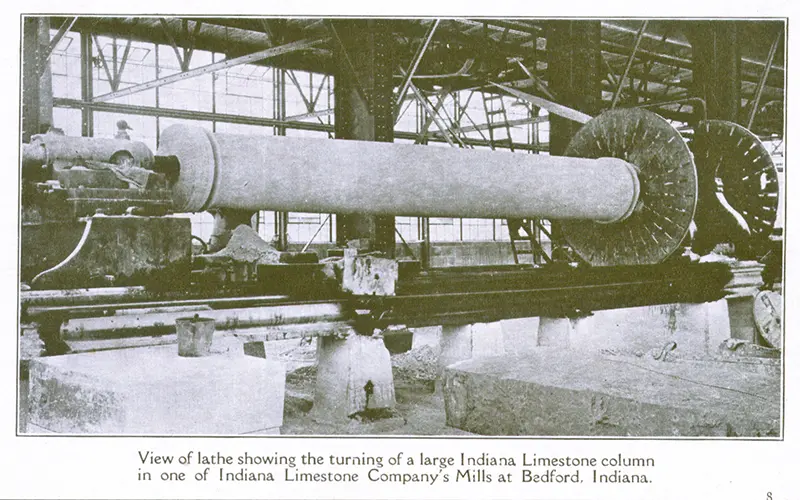
Indiana Limestone Company: Turning a column, Bedford, Indiana
View of lathe showing the turning of a large Indiana Limestone column in one of Indiana Limestone Company's Mills at Bedford, Indiana
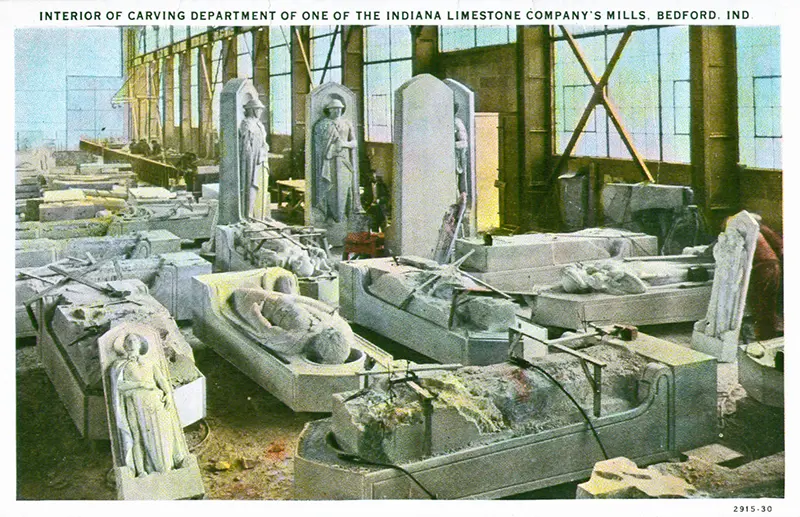
Indiana Limestone Company: Carving Department, Bedford, Indiana
This unused postcard has the printed text...
2915-30
Made by Curt Teich & Co., Inc., Chicago, U. S. A.
Curt Teich, Chicago trademark logo